Types of Indoor Palm Trees – Identification + Pictures
There are about 2500 species of palm trees, but not all of them are suitable as indoor plants. Some types of palm trees are too tall to be grown indoors and that’s why short varieties are the obvious choice. So, what types of indoor palm plants can you choose from?
The best types of palm trees for indoor spaces include the lady palm, kentia palm, Chinese fern palm, ponytail palm, areca palm, and parlor palm. These varieties are easy to care for, don’t grow too tall, and produce a beautiful canopy for indoor beautification.
Although most palm trees can grow indoors just fine, make sure you can provide enough light and water for these plants to grow healthy. Keep in mind that the trees listed below are not tall indoor trees, so they can be grown in houses with a relatively short height.
Are palm trees good indoors?

Palm trees are great indoor plants due to their tropical beauty and low maintenance requirements. They’re also less-susceptible to pest infestations and can thrive as indoor potted as well as outdoor plants.
Indoor palm trees are also good air purifying plants and typical indoor environments are great for most species of palms to thrive. These plants typically need warm temperatures, coupled with moderate humidity and lighting. Such conditions are quite easy to achieve in an interior space.
6 Best Types of Indoor Palm Trees
The general perception is that palm trees have tall trunks that make them suitable as outdoor plants in tropic and subtropic climates. In some cases, palm trees are compared to coconut trees due to their similarities.
There are some varieties of palm trees that can grow indoors successfully if provided with increased humidity, bright indirect sunlight and enough water.
Here are the best types of indoor palm trees:
1. Kentia Palm
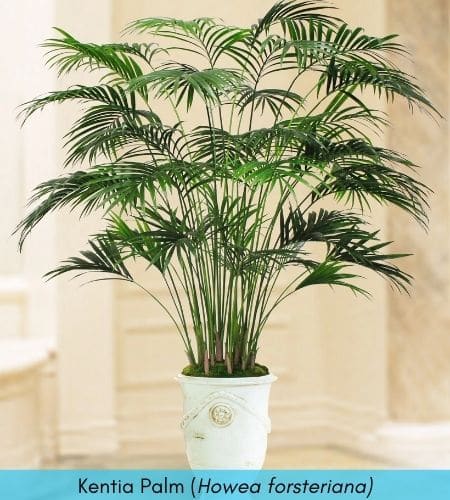
Known to some by its scientific name, Howea forsteriana, Kentia Palm is one of the most popular palms amongst indoor gardening enthusiasts.
Here are the care requirements for Kentia palms:
| Water | Once a week |
| Humidity | 49% – 55% humidity |
| Light | Indirect sunlight |
| Temperature | 55°F – 85°F |
Identification: Due to its dense, feathery fronds, this pinnate palm has a classical palm look that elicits a sense of tropical relaxation.
Kentia palms are great for indoor spaces with poor sunlight exposure, as they exhibit incredible shade tolerance while retaining their lush green shade even in dimly-lit settings.
While Kentia palm plants are moderately drought-resistant, they thrive when you provide them with enough water, sunlight, and airflow. You should- thus- ensure you have proper indoor sunlight exposure and ventilation.
They’re also relatively pest-resistant, as they barely show any visible signs of damage/poor plant health when attacked by mealy bugs or spider mites. Kentia palms are also moderately tolerant of low humidity conditions. This palm species is a slow grower, but will grow significantly faster in an indoor gardenscape than when potted.
2. Lady Palm
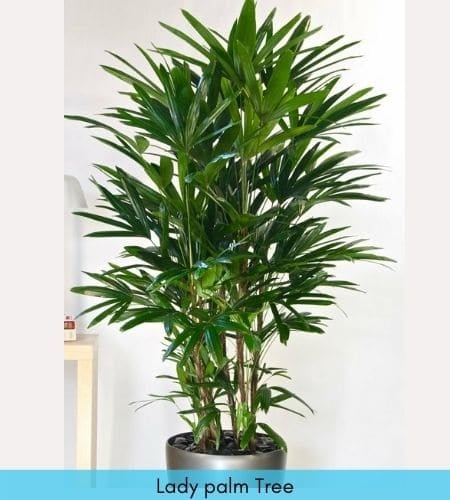
| Water | 1-2 times a week |
| Humidity | 50% humidity or higher |
| Light | Full indirect sunlight |
| Temperature | 60°F – 80°F |
Native to Asia, Rhapis excelsa, or the Lady Palm, is a slow-growing palm species. So- if you don’t like having to repot your houseplants into a larger vase every so often as they outgrow the old one, you’ll surely love this one. If you prefer fully-mature, lush-looking houseplants, you can ask for fully-grown lady palms from your local plant nursery.
Some hybrid cultivars of the lady palm have beautiful, multicolored variegation, making them great ornamental houseplants. Take note- however- that such hybrid cultivars are typically costly and have high maintenance requirements in terms of light and water requirements.
The lady palm also boasts fairly good pest tolerance (spider mites) and drought resistance. However, it has poor shade tolerance. Thus, to keep your indoor lady palms healthy, ensure you provide bright, indirect sunlight. Remember, this palm species is just as intolerant of direct sunlight as it is to low light conditions.
3. Chinese Fan Palm
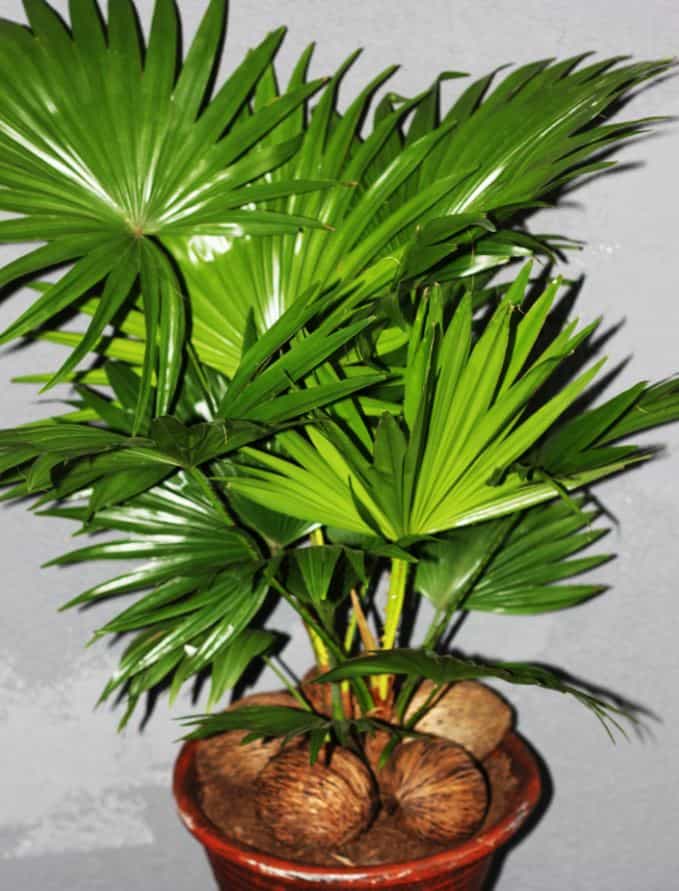
| Water | 2-3 times a week |
| Humidity | 50% humidity or higher |
| Light | Bright filtered light |
| Temperature | 65°F – 80°F |
Scientifically known as Livistona chinensis, the Chinese Fan Palm, is one of the relatively low-maintenance palm species. It’s also one of the best types of palms for adding a touch of natural beauty to your indoor areas due to its distinctive star-shaped fronds.
Choose this type of indoor palm tree if your indoor space measures at least 16-feet from floor to ceiling because the Chinese fan palm is a tall indoor tree even though the root system of the palm is shallow. Otherwise, you’re better off going for a dwarf subspecies such as subglobosa. A normal Chinese fern palm can measure up to 15 feet tall when fully grown.
However, this species of palm is a slow grower and exhibits strong shade tolerance while younger. Mature Chinese fern palms- on the other hand- prefer bright, filtered lighting. It’s also advisable to grow your Chinese fern palm in a large pot or an indoor garden as a regular pot may not be spacious enough for its long taproot.
Finally, this species of palm requires occasional irrigation. Never let the topsoil go completely dry.
4. Parlor palm
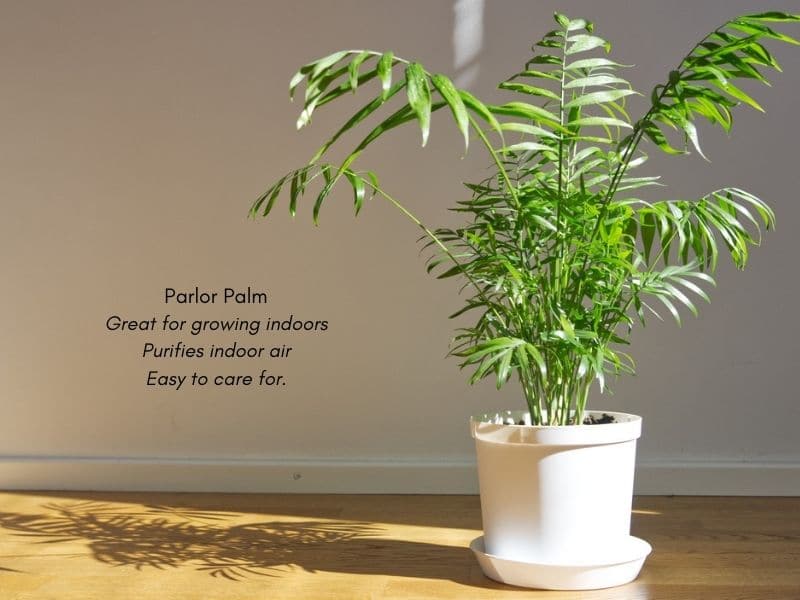
| Water | Every 1-2 weeks |
| Humidity | 50% – 60% humidity |
| Light | Low or bright filtered light |
| Temperature | 65°F – 85°F |
Arguably the most drought-tolerant indoor palm species on this list, Chamaedorea elegans– or Parlor palm, is a favorite amongst lazy gardeners. Its relatively small size and thin fronds also make it great for indoor settings where space may be limited.
The plant’s single, green stem has white rings around it- a characteristic that adds a unique ornamental appeal. Parlor palm’s light-textured fronds and clustering growth pattern also adds to its aesthetic appeal.
Parlor palms exhibit shade-tolerance. They can- therefore- be used as decorative plants even in typically darker indoor spaces such as a basement study room. However, this palm species is very vulnerable to spider mites, as these pests ‘kill off’ the plant’s fronds. As such, you should always ensure the soil in which your parlor palm grows is never completely dry. This will minimize chances of spider mite infestation. Finally, this popular houseplant is not poisonous to humans or animals.
5. Ponytail Palm
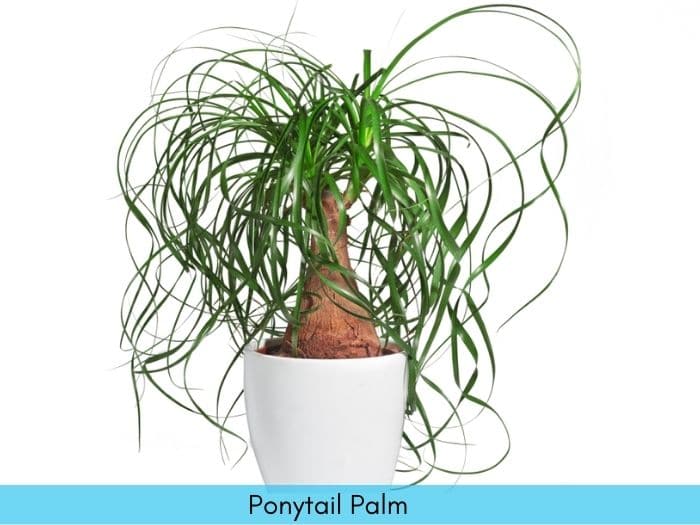
| Water | Once a week |
| Humidity | 40% – 50% humidity |
| Light | Bright indirect light |
| Temperature | 60°F – 80°F |
If you live in a studio apartment where space is a huge consideration when choosing suitable indoor plants, the best type of indoor palm tree for you is the ponytail palm.
Scientifically referred to as Beaucarnea recurvate, this palm species barely grows past 4 feet indoors. The ponytail palm’s arching leaves and swollen trunk make it an outstanding ornamental plant.
The trunk also stores water, making this type of palm drought-tolerant and great for those who aren’t always at home to provide plant maintenance. Nevertheless, you should water it at least once every fortnight.
Ponytail palms thrive when exposed to full, direct sunlight. You should also fertilize your ponytail palm at least once a year- preferably during spring- to maintain the beautiful, light-green appearance of the plant’s leaves. Another major consideration that makes this palm great for indoor settings is that its pet-safe. You won’t have to worry about your cat or dog getting poisoned.
6. Areca Palm

| Water | Every 2-3 days |
| Humidity | 40% – 50% moisture level |
| Light | Bright filtered sunlight |
| Temperature | 65°F – 75°F |
Areca palm is a palm species that’s also known by a host of other names including Dypsis lutescens, yellow, palm, golden cane palm, and butterfly. However, it’s the last name that’s perhaps most definitive of this plant’s physical appearance; as its hairy, arched leaves resemble a butterfly.
Areca palms are considered perfect for indoor settings owing to their clumpy growth pattern and thin, arching fronds. What’s more, this plant’s lush green foliage adds a sense of natural beauty to diverse types of interior décor. You’ll- however- have to water regularly to ensure the soil stays moist if you want to bring the best out of your Areca palms plants.
Areca palms thrive in bright, indirect sunlight. Therefore, if you must place them next to a window that lets in a great amount of sunlight, you can filter out some of the sun’s rays by installing a sheer curtain. These palm plants are also intolerant to high levels of fertilizer salts in the soil. You’ll- therefore- want to avoid over-fertilizing your areca palms. To prevent the build-up of fertilizer salts in the substrate, flush the soil periodically and apply fertilizer no more than twice during the peak growth seasons.
Which palm tree is best for indoors?
The best palm tree for indoor environments will vary from one homeowner to the next. For instance, if you’re not always at home, it’s advisable to go for a palm plant variety that doesn’t require regular watering. We also recommend choosing an indoor palm type that has moderate-strong resistance to pests and diseases.
The general weather conditions in your region may also help you determine which species of palm is best for your indoor space. If you stay in an area that stays cold for most parts of the year, you may want to avoid palms that have low cold-tolerance and go for the cold-hardy varieties instead.
However, if you must go for a palm type that cannot withstand cold conditions, ensure you’ve installed an indoor heating system within the room in which the palms are.
The growth rate of a palm species may also determine if it’s great for indoor spaces or not. You’d prefer slow-growing houseplants that you can care for for years before they outgrow the interior space intended for them.
One of the best indoor palm trees is the Fish-tail Palm (Caryota mitis) because of its distinct beauty, but in some cases, it may not be the best for your indoor setting it grows faster than other palm species listed in this article.
Another important yet often overlooked consideration when selecting the best indoor palm trees is the height. Miniature/dwarf palm varieties are great for indoor spaces where vertical space may be limited. Examples of low-growing palm species that don’t exceed 12-feet when fully mature include parlor palm, pygmy date palm, bottle palm, and spindle palm.
Resources
- Colorado State University Extension: Palms as Indoor Plants
- Edward F. Gilman, University of Florida, IFAS Extension: Chamaedorea elegans Parlor Palm, Neanthe Bella


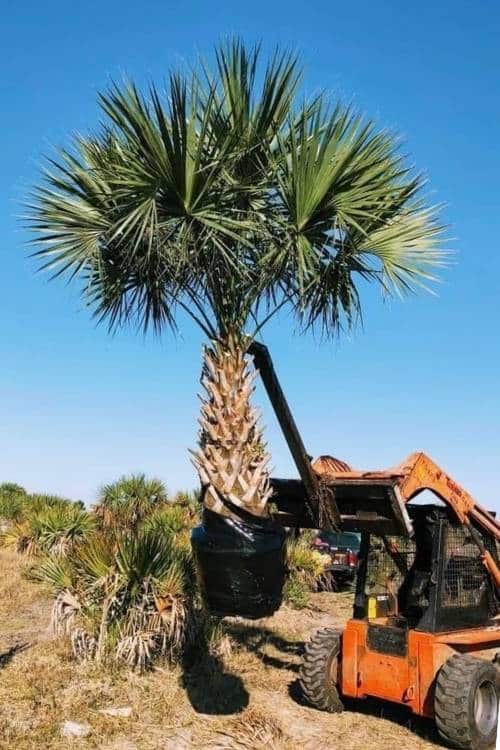
![Palm Tree Roots – How Deep Do They Grow? [Facts]](https://gardenine.com/wp-content/uploads/2021/03/Palm-tree-root-system-diagram.jpg)
